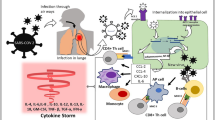Abstract
Elderly patients are having high mortality rates from COVID-19/SARS-CoV-2 infection compared to younger patients. The SARS-CoV-2 virus uses the ACE2 receptor as the entry point to the host cells. ARBs/ACEIs which are widely used in elderly patients, have been found to be associated with overexpression of ACE2.To decrease the severity of COVID-19 infection, ARB/ACEI should be switched to another class drug not known to cause a rise in ACE2 until the COVID-19 infection subsides. Specific human immunoglobulin can be tried for COVID-19 patients with critical conditions under supervision.
Similar content being viewed by others
Introduction
On 11 March 2020, the WHO informed that COVID-19/SARS-CoV-2 can be characterized as a pandemic. Hoffmann et al. found that SARS-CoV-2 uses the angiotensin-converting enzyme 2 (ACE2) for host cell entry [1]. Elderly people are found to be more susceptible to this infection [2]. This indicates a possible link in elderly patients of increased ACE2 levels to some preexisting comorbid conditions. Zhang et al. found that the common comorbid conditions associated with COVID-19/SARS-CoV-2 were hypertension and diabetes mellitus [3]. Earlier studies by Wang et al. and Furuhashi et al. have found that angiotensin II receptor blockers (ARB) and angiotensin-converting enzyme inhibitors (ACEI) have been associated with overexpression of ACE2. This points towards a possible link between the severity of COVID-19 and use of ARB and ACEI [4, 5].
Discussion
My hypothesis proposes that a decrease in ACE levels can cause an increase in ACE2 expression. Studies by Wang et al. and Furuhashi et al. support this hypothesis. Wang et al. had found that use of ACEI is associated with overexpression of ACE2 [4]. Furuhashi et al. had found that ARBs are also associated with overexpression of ACE2 [5]. ARB and ACEI are widely used as one of the first-line drugs in hypertensive diabetic patients, diabetic nephropathy, and congestive cardiac failure, etc. These are very commonly witnessed comorbidities associated with many elderly patients. Hoffmann et al. found that SARS-CoV-2 uses the ACE2 as a receptor to enter the host cell, and the presence of overexpression of ACE2 can lead to a more severe form of COVID-19 infection [1]. This might be a possible explanation of why elderly patients with hypertension and diabetes are more affected by SARS-CoV-2 and why mortality rates are higher among them [6].
Many patients are also recovering from the current COVID-19 pandemic. The collection of specific human immunoglobulin from them and using the same for critically ill patients under strict supervision can be a life-saving measure. Earlier, Cheng et al. had found promising results using convalescent plasma therapy in SARS patients in Hong Kong [7]. My hypothesis is specific human immunoglobulin may be used as a standard protocol of therapy for any unknown viral pandemic.
Conclusion
In conclusion, the following steps need to be taken urgently to slow down and reduce the severity of this ongoing COVID-19 pandemic:
- 1.
Social distancing is the most important measure.
- 2.
Personal hygiene should be strictly maintained.
- 3.
Try to avoid contact with the mouth or mucous membrane with unclean hands.
- 4.
Patients suffering from COVID-19 infection who are also receiving ARB or ACEI should be switched to another class of drug not known to cause a rise in ACE2 until the COVID-19/SARS-CoV-2 infection subsides. This should only happen following careful consideration of all possible complications resulting from a temporary change in drug.
- 5.
Specific immunoglobulin from cured patients of COVID-19 should be collected and, under strict supervision, used for critically ill COVID-19-infected patients. In future, this may be considered as a standard therapy protocol for the treatment of any unkown viral pandemic.
References
Hoffmann et al., SARS-CoV-2 cell entry depends on ACE2 and TMPRSS2 and is blocked by a clinically proven protease inhibitor, Cell 2020.j.cell.2020.02.052.
Wang W, Tang J, Wei F. Updated understanding of the outbreak of 2019 novel coronavirus (2019-nCoV) in Wuhan, China. J Med Virol. 2020;92:441–7.
Zhang, Jin-Jin, et al. Clinical characteristics of 140 patients infected with SARS-CoV-2 in Wuhan, China. Allergy. 2020.
Wang G, Lai FM, Lai K, et al. Urinary mRNA expression of ACE and ACE2 in human type 2 diabetic nephropathy. Diabetologia. 2008;51:1062.
Furuhashi M, Moniwa N, Mita T, Fuseya T, Ishimura S, Ohno K, et al. Urinary angiotensin-converting enzyme 2 in hypertensive patients may be increased by olmesartan, an angiotensin II receptor blocker. Am J Hypertens. January 2015;28(1):15–21.
Porcheddu R, Serra C, Kelvin D, Kelvin N, Rubino S. Similarity in case fatality rates (CFR) of COVID-19/SARS-COV-2 in Italy and China. J Infect Dev Ctries. 2020;14:125–8.
Cheng Y, Wong R, Soo YO, Wong WS, Lee CK, Ng MH, et al. Use of convalescent plasma therapy in SARS patients in Hong Kong. Eur J Clin Microbiol Infect Dis. 2005;24(1):44–6. https://doi.org/10.1007/s10096-004-1271-9.
Author information
Authors and Affiliations
Corresponding author
Additional information
Publisher’s Note
Springer Nature remains neutral with regard to jurisdictional claims in published maps and institutional affiliations.
This article is part of the Topical Collection on COVID-19
Rights and permissions
About this article
Cite this article
Chatterjee, S. Important Steps to Control COVID-19/SARS-CoV-2 Infection. SN Compr. Clin. Med. 2, 381–382 (2020). https://doi.org/10.1007/s42399-020-00271-7
Accepted:
Published:
Issue Date:
DOI: https://doi.org/10.1007/s42399-020-00271-7




